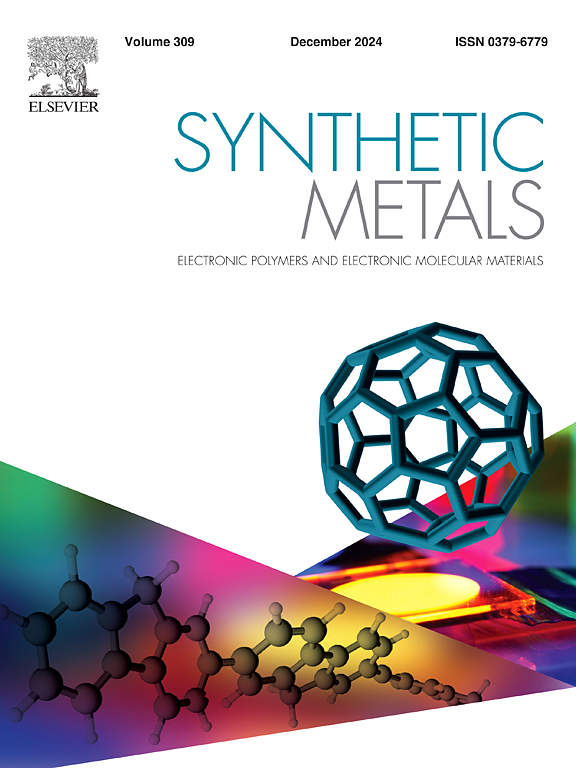氟化喹诺啉-二噻吩吡咯供体-受体共聚物:通过综合实验和理论分析探索结构-性能关系
IF 4.6
3区 材料科学
Q2 MATERIALS SCIENCE, MULTIDISCIPLINARY
引用次数: 0
摘要
通过Stille偶联反应合成了PDTPQx0F和PDTPQx2F两种供受体(D-A)半导体共聚物。共聚物包括二噻吩吡咯(强供电子部分)与非氟化或氟化(电子接受单位)的喹诺啉衍生物配对。由于其定制的电子和光学特性,这种材料在光电器件应用中显示出巨大的潜力。采用紫外-可见光谱、1H NMR、CV、GPC、TGA、XRD等综合表征技术对其热稳定性、电化学行为、光学性质和固态分子组织进行了表征。系统地研究了在喹啉单元中加入两个氟原子的影响。两种共聚物均表现出优异的热稳定性,分解温度均超过410℃。非氟化化合物的光学带隙(Egopt)为1.77 eV, HOMO能级为−5.0 eV。有趣的是,与PDTPQx0F(8500 Da)相比,氟化化合物(PDTPQx2F)的分子量(12100 Da)更高,因此具有更窄的Egopt(1.60 eV)和相当的HOMO水平。XRD分析表明,氟化通过促进固态聚合物链之间更强的π-π堆叠相互作用,显著增强了分子的组织。这种增强的有序性突出了氟取代在调节D-A共聚物的结构和电子性能方面的关键作用,可用于先进的光电应用。此外,进行了DFT计算来预测所研究化合物的光学性质。先进的理论分析,包括RDG, ELF和QTAIM-NCI,用于研究这些化合物内部的相互作用。本文章由计算机程序翻译,如有差异,请以英文原文为准。
Fluorinated quinoxaline-dithienopyrrole donor-acceptor copolymers: Probing structure-property relationships via integrated experimental and theoretical analysis
Two donor-acceptor (D-A) semiconducting copolymers, PDTPQx0F and PDTPQx2F, were synthesized via the Stille coupling reaction. The copolymers comprise dithienopyrrole (a strong electron-donating moiety) paired with quinoxaline derivatives that are either non-fluorinated or fluorinated (electron-accepting units). Such materials demonstrate significant potential for optoelectronic device applications due to their tailored electronic and optical properties. A comprehensive characterization technique, including UV-Vis spectroscopy, 1H NMR, CV, GPC, TGA and XRD, were employed to examine their thermal stability, electrochemical behaviour, optical properties, and molecular organization in the solid-state. The impact of incorporating two fluorine atoms into the quinoxaline unit was systematically investigated. Both copolymers exhibited excellent thermal stability, with decomposition temperatures exceeding 410 °C. The non-fluorinated compound exhibited an optical bandgap (Egopt) of 1.77 eV and a HOMO energy level of −5.0 eV. Interestingly, the fluorinated compound (PDTPQx2F) exhibited a narrower Egopt of 1.60 eV and a comparable HOMO level, attributed to its higher molecular weight (12100 Da) compared to PDTPQx0F (8500 Da). XRD analysis revealed that fluorination significantly enhances molecular organization by promoting stronger π-π stacking interactions between polymer chains in the solid state. This enhanced ordering highlights the critical role of fluorine substitution in modulating the structural and electronic properties of D-A copolymers for advanced optoelectronic applications. Additionally, DFT calculations were performed to predict the optical properties of the studied compounds. Advanced theoretical analyses, including RDG, ELF, and QTAIM-NCI, were utilized to investigate the interactions within these compounds.
求助全文
通过发布文献求助,成功后即可免费获取论文全文。
去求助
来源期刊

Synthetic Metals
工程技术-材料科学:综合
CiteScore
8.30
自引率
4.50%
发文量
189
审稿时长
33 days
期刊介绍:
This journal is an international medium for the rapid publication of original research papers, short communications and subject reviews dealing with research on and applications of electronic polymers and electronic molecular materials including novel carbon architectures. These functional materials have the properties of metals, semiconductors or magnets and are distinguishable from elemental and alloy/binary metals, semiconductors and magnets.
 求助内容:
求助内容: 应助结果提醒方式:
应助结果提醒方式:


